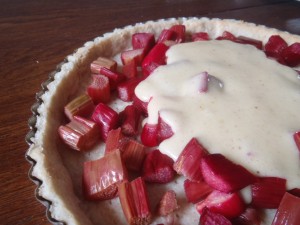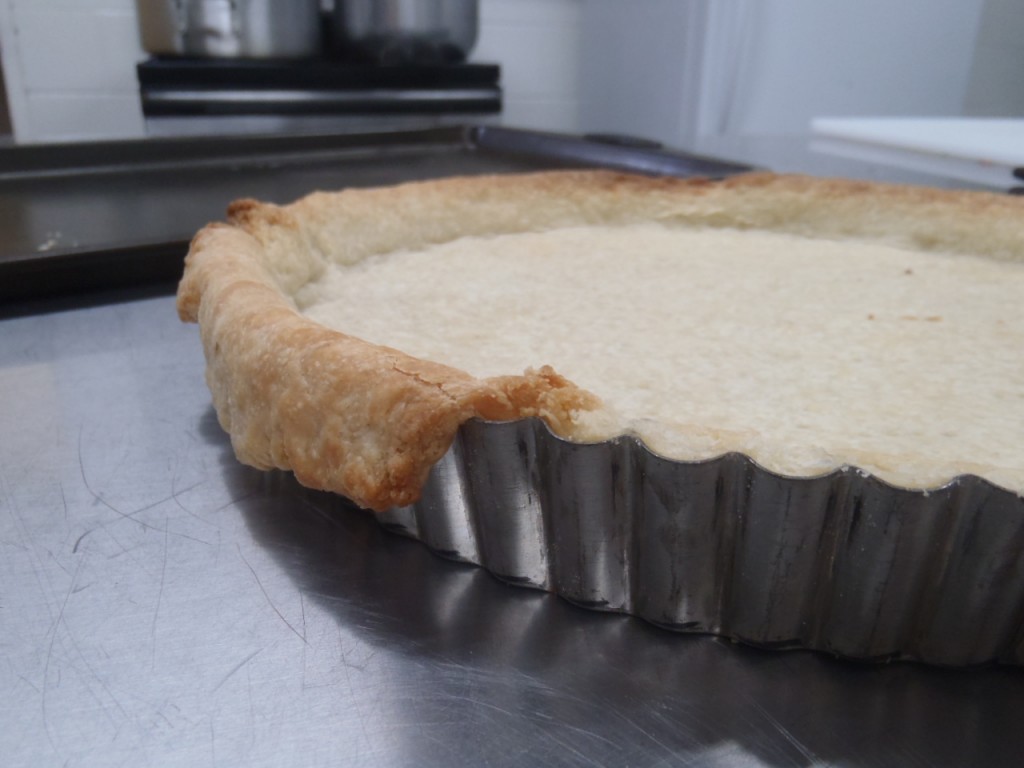 In North America, this style of dough is called tart dough, or possibly short dough. In France it’s known as pâte brisée.[1]
In North America, this style of dough is called tart dough, or possibly short dough. In France it’s known as pâte brisée.[1]
Pie dough has clumps of butter that separate the sheets of flour and water, creating a tender, flaky crust. Tart dough is not flaky. It has a very fine, even texture, and a delicate crispiness. Actually it’s kind of like a thin shortbread cookie. The butter is incorporated as tiny uniform pieces, instead of the irregular chunks in pie dough. The cook also has to be careful not to develop too much gluten, otherwise the cooked tart will be tough.
Besides being the base for classic tarts, this dough could also be used for custard-type pies, like pumpkin pie. The recipe actually uses the same rough ratio as the pie dough, only the nature of the liquid component is different, and a bit of sugar is added. Also the ingredients are mixed differently to manipulate the final texture of the dough.
Tart Dough Ratio – 3:2:1:1 flour, fat, liquid, sugar
- The flour is cake and pastry flour. Actually cake flour would be ideal, as it has the highest starch and the lowest protein content, and therefore won’t develop too much gluten.
- The fat is unsalted butter.
- The liquid is the biggest change from normal pie dough. Instead of using ice water, we use an equal blend of egg yolks and heavy cream. The extra fat will further prevent the development of gluten.
- The sugar, added in equal amounts as the liquid by weight, will sweeten the dough and help it develop a crisp texture.
- A pinch of salt is a good thing.
Mixing. Combine the flour, sugar, salt. We want the butter in very small pieces, evenly distributed throughout the dough. You can use a traditional cutting-in method if you’re very thorough, but it’s easier to put the dry ingredients and the butter into a food processor and pulse the blades until the fat is incorporated. Then add the liquid. Mix to combine, then knead briefly, until the dough is smooth. Wrap tightly and refrigerate at least an hour before rolling out.
Shaping and Baking. As mentioned above, this dough can be used in all sorts of baked goods, including individual, cup-shaped tarts, pumpkin pies. The most elegant mold for this dough is a classic French tart shell. These are about 1″ deep, 10″ across, and have distinctive fluted edges. Most French tart recipes call for the dough to be blind baked, that is, partially or completely baked baked before any filling is added. Some fillings require no baking (eg. tarte au sucre), and in that case the dough should be fully baked beforehand. Other fillings, like those based on custards, require a gentle bake, in which case the dough should be partially baked beforehand.
For blind baking, we line the tart shell with the dough, then “dock” the dough, which means punch hundreds of little holes in the dough sitting on the bottom of the tart pan. This can be performed by a “docker,” which looks like a tiny lawn aerator, or by a fork, repeatedly jammed into the pastry. Docking prevents the formation of bubbles and blisters during blind baking.
Blind baking also typically involves lining the tart dough with parchment and then piling some beans, or other dried legumes, or pie weights on top. This also prevents bubbling, and keeps the dough in place during baking.
There’s one more trick to making the perfect blind baked tart dough….
It took me a long time to figure out how to make French tarts look good. For a while, no matter what dough recipe I used, or how thoroughly I chilled it, or how high I filled the shell with baking beans, the pastry would slough down the sides of the pan during baking.
I finally came across a simple solution in Marco Pierre White’s autobiography. One of the classic dishes he served at Harvey’s was tarte au citron, lemon tart. He would roll out the dough so that when pressed into the pan it draped over the edge. After baking he would trim the dough so that it was perfectly flush with the sides of the pan.
Again, exact baking specifications will vary, but a modified two-stage method is usually employed. Maybe fifteen minutes on a lower rack at 375°F to brown the bottom, then fifteen minutes on a higher rack at 350°F. That’s just a guideline, mind you.
Footnotes
1. Sorry to be a dick about this, but do you see the difference between “pâte” and “pâté”? “Pâté”, as in, the ground mixture of meat and liver, ends with an “é”, with an accent, so it’s pronounced, “pat-EH.” “Pâte,” as in the tart dough we’re presently discussing, has no such accent, and is therefore pronounced, “PAT.”
